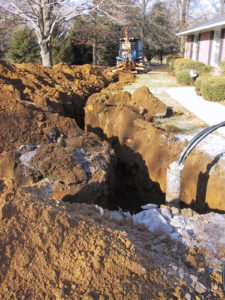Experts for Geothermal Heating and Air Conditioning
Geothermal systems are nothing new at Sinton Air Conditioning & Heating, Inc. Since the 1970’s when oil and fuel prices surged, we have offered Geothermal solutions. We proudly install, service and maintain WaterFurnace International geothermal systems!
A major source of energy is right under your feet.
Your own backyard has the potential to be your source of heating and cooling comfort. Now you can get safe, reliable, energy efficient heating and cooling from one piece of equipment. Geothermal energy represents the leading edge of heating and cooling technology. It moves heat energy to and from the earth to heat and cool your indoor environment. And compared to ordinary systems, geo-thermal technology can save you 30% to 70% on your monthly energy bills. Geothermal is the safest, cleanest, most reliable space conditioning system you can buy.
Geo-thermal energy is an unlimited resource. The lot surrounding a suburban home or other building contains a vast reservoir of low temperature thermal energy, typically 10 times that required over an entire heating season. This resource is constantly resupplied by the sun, the surrounding earth, and heat rejected while cooling during the summer. The universal definition of geothermal is “…pertaining to the heat of the earth.” By using the earth to provide 100% of a building’s total heating and cooling needs, GHP systems are truly geothermal energy made practical.
Geo-thermal heat pump systems are not do-it-yourself projects. To ensure proper results, the piping should be installed by professionals who follow procedures established by the International Ground Source Heat Pump Association (IGSHPA). Designing the system also calls for professional expertise: the length of the loop depends upon a number of factors, including the type of loop configuration used; your home’s heating and air conditioning load; local soil conditions and landscaping; and the severity of your climate. Larger homes requiring more heating or air conditioning generally need larger loops than smaller homes. Homes in climates where temperatures are extreme also generally require larger loops.
To date, geo-thermal heat pumps are an under-used technology, merely because few people are aware of it’s potential. The Department of Energy’s Office of Geo-thermal Technologies, however, wants to increase installations of geothermal systems to about 400,000 a year by 2005. If the goal is reached, that would mean that 2 million systems would be in service, saving consumers over $400 million per year in energy bills and reducing U.S. greenhouse gas emissions by over 1 million metric tons of carbon each year.
- 30% of total system cost in 2022 through 2032
- 26% of total system cost in 2033
- 22% of total system cost in 2034
- No limit to credit amount
- Can be used to offset alternative minimum tax (AMT)
- Can be used in more than one year
- Can be combined with solar and wind tax credits
- Can be combined with energy efficiency upgrade credits
What’s Eligible: Geothermal equipment that uses the stored solar energy from the ground for heating and cooling and that meets ENERGY STAR requirements at the time of installation is eligible for the tax credit. Covered expenditures include labor for onsite preparation, assembly, or original system installation and for piping or wiring to connect a system to the home. The structure must be located in the United States and used as a residence by the taxpayer, although primary residency isn’t required. In fact, if geothermal is installed in more than one home, there’s no limitation on the number of times the credit can be claimed.
What’s Not: The credit can’t be claimed for spending on equipment used solely for hot tub or pool conditioning, nor on previously used equipment. Rental home installations also cannot be claimed. As of November 2013, electric strip heat and ductwork distribution systems are no longer included in the tax credit calculation.
How to Claim the Credit: Use IRS Form 5695 to claim the Residential Energy Efficient Property Credit, and there’s no limit on the credit amount. The tax credit can be used to offset both regular income taxes and alternative minimum taxes (AMT). If the federal tax credit exceeds tax liability, the excess amount may be carried forward into future years. Spending on geothermal heat pump property adds to your home’s cost basis but also must be reduced by the amount of the tax credit received.
Learn more about offers and rebates
Geo-thermal Systems
Geo-thermal Heat Pump for Home and Commercial Comfort


